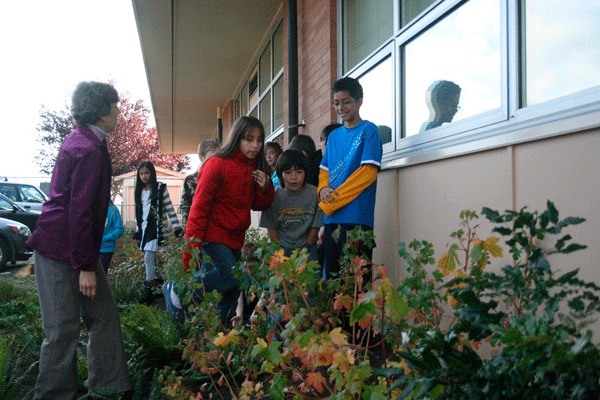Fifth grade students at Crescent Harbor Elementary School greeted their rain garden with “oohs” of delight at how much it has grown in the nearly two years since they planted it. The tiny strawberry plants flourished and now cover the ground alongside moss, ferns, bleeding hearts and other plants native to the area.
While the garden adds a swatch of green between the school buildings and parking lot, its real purpose is revealed when it rains. Water running off the pavement flows over the garden like a little stream.
“The rain garden sucks up all the water and purifies it,” said fifth grade student Gabrielle Luffman.
The cars in the adjacent parking lot leak oil and toxins, which run into the ground with stormwater, explained fifth grade student Aspen Kemper. Instead of allowing those toxins to poison waterways, the rain garden purifies the water.
An estimated 140,000 pounds of toxins go into Puget Sound every day from stormwater run off, said Maribeth Crandell, environmental educator for the city of Oak Harbor. Toxins come from automotive fluids, pet waste, car wash soap, pesticides, fertilizers, wash water and kitchen grease.
The city has been focusing on low impact development, which involves slowing and filtering stormwater via porous pavement, such as at the Scenic Heights Trailhead parking lot, green roofs, like at Fort Casey State Park, and rain gardens, meant to mimic natural wetlands that collect, slow and filter stormwater runoff to recharge Whidbey Island aquifers, Crandell said.
Rain gardens have become popular all around Oak Harbor. They have been built at more than six sites, including Fort Nugent Park, Oak Harbor High School and Wallin Funeral Home.
“We’re in there with everyone else trying to save the world one step at a time,” said Bobbie Cane, the teacher leading the project.
Over the course of the project, students learned about soil and the creation of the garden via guest speakers, including members of the Whidbey Island Conservation District and Cane’s husband, Greg Cane, an engineer.
A happy memory for the students was learning about layers of soil through a tasty layer cake. One of the students’ favorite parts of the project came on the first big day of planting.
“It was fun to climb on the piles of dirt,” said student Katelynn Durand. She said she especially enjoyed planting the snowberries because they were so large.
Along with learning how to work with community members and businesses that helped with planning, teaching and planting, students learned that they can make a difference.
“It’s important to keep the world safe,” Kemper said.
“We’re going to keep the world safe one little plant at a time,” Luffman said.
“One garden can make a difference,” Durand added.
It isn’t very expensive to make a residential rain garden and could be free for those willing to expend a lot of energy, Crandell said. They require composting soil that allows water to soak in rapidly. It’s best to use native plants, but not edible vegetables since the plants’ purpose is to filter or absorb toxins.
The best place to construct a rain garden is in an urban area with a lot of pavement. Rain gardens shouldn’t be placed on bluffs because they will saturate the bluff, Crandell said.
Members of the Whidbey Island Conservation District will visit homes to help residents plan their gardens.
A step-by-step manual for building rain gardens is available on the conservation district’s website, whidbeycd.org, under “Low Impact Development.”
The rain garden is an ongoing project as Cane and younger students continue to weed and care for the garden. Even as the students who first planted the garden move on from elementary school they leave behind a patch of green positively impacting Whidbey Island.
“You’ll always have this to remember,” Cane told her students.



